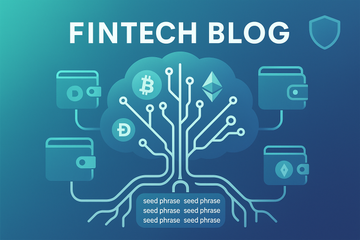Let’s be real—handling crypto used to feel like juggling flaming swords. For every new transaction, you’d have to secure a new private key, scribble it down somewhere safe, sweat a little, and hope you hadn’t miswritten a single character. Mess up once, and boom, say goodbye to your coins. That’s why the arrival of Hierarchical Deterministic wallets, or HD wallets, was such a game-changer. But what actually makes them tick?
Why Old-School Wallets Gave Us Headaches
Think about early wallets—those basically let you create a handful of cryptocurrency addresses, but every new address demanded its own backup. Lose one? That stash of Bitcoin could be lost forever. Record keeping was a pain and, honestly, gave more than a few folks heart palpitations. It was like having a box crammed with unlabeled keys—but which one opened the vault?
So, What’s a Hierarchical Deterministic Wallet, Anyway?
Here’s the thing: instead of separate house keys, all HD wallets start with a single, powerful key called a seed phrase, often 12 to 24 everyday words. Using this, the wallet generates a mind-bending number of unique addresses, all mathematically connected. It’s like owning a magic master key that lets you create a new room (wallet address) any time you need—no need for extra lockboxes!
Technically, hierarchical refers to how each new address is like a branch growing out from the same tree trunk (your seed). Deterministic? That just means the tree will always look the same if you plant the same seed. Predictable, yet staggeringly secure.
The Secret Recipe: Tree Structure and Seed Phrases
Picture your HD wallet as a vast family tree. There’s a single ancestor (the master seed) and countless descendants (child keys and addresses). Each branch—whether it’s a savings account or a daily spending wallet—can be tracked, recovered, or even separated for privacy, all from just that original seed. Neat, right?
Want to manage Bitcoin, Ethereum, even that obscure Dogecoin stash? No problem—if the wallet follows standards like BIP32 and BIP44, you can spawn addresses for multiple cryptocurrencies, all inside your single vault. Lose your phone? As long as you remember (and fiercely protect!) that backup phrase, your whole crypto world can be restored. It’s like having a get-out-of-jail-free card, except much rarer and, hopefully, better hidden.
Why You Should Care: Real-World Perks
- Privacy baked in: New address for every payment, so strangers can’t stalk your whole financial life on the blockchain. Pretty comforting.
- Scalability: Juggle multiple coins, accounts, even future blockchain assets, all branched elegantly within one wallet.
- Stupid-easy backups: Write down one seed phrase and you’re set. No more frantic “Where did I put that key?” panic.
- Industry-wide compatibility: Since most wallets now use these common standards, migrating to a fancier device or app doesn’t have to mean starting from scratch.
Still, nothing comes risk-free in crypto. If someone nabs your seed phrase, they own everything. Seriously, never digitally store it or share it. Tattoo it on your soul, not your Dropbox.
Sneak Peek: How the Magic Happens Under the Hood
For the folks who love a bit of tech under the hood: HD wallets use math that’s pretty impressive even to seasoned cryptographers. Starting with that seed phrase, your wallet applies formulas (like those set out in the BIP32 and BIP44 standards) to generate tree-structured paths: think '/m/44'/0'/0'/0/0' as a road map to a specific account or coin. Each path means another safe, unique address.
Whether you stick with software wallets like Electrum or fly high with hardware wallets like Trezor and Ledger, you’re basically wielding a sophisticated branch of digital security—all from a handful of words. Honestly, it’s kind of poetic in its simplicity.
Hardware Wallets: Where HD Meets Hardcore Security
Maybe you’ve heard the names: Trezor and Ledger. These two giants use HD wallet tech right at their core. Why? Because when you lock your seed phrase inside a physical device—with PIN codes, secure chips, and no web access—no hacker can wriggle in by guessing your cat’s birthday. Your seed phrase stays offline, and even if you connect your wallet to a dodgy laptop, your treasure chest won’t flinch. That physical isolation, mixed with a backup phrase, is why even pros sleep easy with hardware wallets.
But Wait, Is It All Rainbows?
Well, here’s a quirky contradiction—HD wallets are so convenient that some folks get careless. They figure, 'I’ve got my magic phrase, what could go wrong?' Plenty. If you misplace that phrase, there’s no magic customer support number. Your crypto is just… gone. Forever. That’s the bittersweet beauty of decentralization and self-custody: ultimate control, ultimate responsibility. You know what? Sometimes, that makes your heart skip every time you see your hand-written seed phrase.
Everyday Analogies: Why This Actually Matters to You
If you’ve ever lost a mailbox key or forgotten which suitcase your passport is in, you get the anxiety of poor backups. HD wallets let you live lighter: one little phrase grants access to your entire mansion of possibilities. It’s why everyone from casual Bitcoin dabblers to deep-pocketed Ethereum whales swears by this structure.
Before You Go: A Handy Checklist
- Use a respected wallet provider (think Trezor or Ledger if security is your deal-breaker).
- Physically write down your seed phrase—store it in a fireproof place.
- Stay up to date with firmware (for hardware wallets) so the bad guys can’t exploit old vulnerabilities.
- Be aware: anyone who gets that seed phrase becomes you, at least in crypto world.
Life’s hectic enough without needless worry over keys and recoveries. With the power of hierarchical deterministic wallets, you’d be hard-pressed to find an easier, safer, or more flexible way to take charge of your crypto future. And hey—if you’re the sentimental type, maybe give your seed phrase a pet name. Just don’t put it on a sticky note on your desk.











